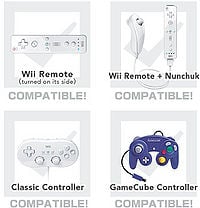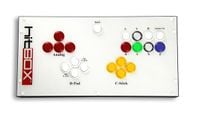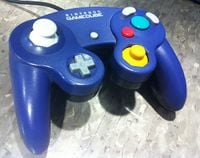Controller

Controllers are used in video games for players to input various commands related to the game's actual gameplay. Throughout the Super Smash Bros. series, the games have been compatible with multiple types of controllers for playing them.
Types of controllers
Nintendo 64 controller
This was the first and only controller to be used in Super Smash Bros. Compatible with the Nintendo 64, the controller rarely sees use in tournaments, owing to the rather small competitive scene for Smash 64. Even in such events, however, Nintendo 64 controllers are not the most commonly used controller, with many players using a variety of other types of unofficial controllers, whether via homebrewing their own controller for the Nintendo 64, or using a standard computer controller or keyboard for setups that use emulators. The relative unpopularity of the Nintendo 64 controller primarily stems from its infamous analog stick; its surface is hard and small, making it uncomfortable for many players to use for long periods of time, and it is also notorious for quickly breaking down under stress, requiring players to constantly spend money to either buy a new controller or replace the stick.
GameCube controller
For Melee, this was the only controller one could use, barring the use of esoteric adapters for other controllers. In addition to its standard, wired model, a wireless version of the controller, the Wavebird, was also released; though identical in function, it does not have the rumble capabilities due to battery life concerns. A later revision, produced in white and sporting a three metre cord instead of a two metre, was also released by Nintendo in April 2008 for Japanese players, and it is mostly associated with Japanese players such as Otori. While difficult to procure in Western territories, some players have imported the controller and used it in tournaments, such as Nairo. A similar controller was also later released in North America for the launch of Super Smash Bros. for Wii U; this version featured a black colour scheme, a three metre cord, and a stylised Super Smash Bros. logo silkscreened onto it.
The GameCube controller can also be used as one of the four options of playing Super Smash Bros. Brawl, via the Wii's built-in GameCube ports. The release of Super Smash Bros. for Virtual Console also added the ability to play the game with the GameCube controller, with the controls even slightly updated to make the controller manipulate the game more similarly to Melee.
While the Wii U does not feature dedicated ports for the controllers, an adapter that plugs into two of the Wii U's various USB ports is produced by Nintendo, allowing for up to four controllers to be plugged in. As the Wii U features four USB ports, this allows for a maximum of eight GameCube controllers to be used for Smash 4. Cheaper third-party options that are functionally identical to the USB adapter are also available. A number of even cheaper options are also available, as adapters that plug directly into the Wii Remote instead of the console, though most of these adapters cause the game to read the GameCube Controllers as Classic Controllers instead.
Within tournaments for Brawl, Project M, and Smash 4, the GameCube controller is by far the most popular option, due to the still-strong tournament scene of Melee and most players having the opinion of the GameCube controller being the best controller for Smash. Additionally, GameCube controllers do not have battery issues and they are considerably easier to connect to a Wii, as they do not require devoted processes for syncing them to different consoles. The Wavebird, however, has not seen frequent use in tournaments, owing to concerns about battery life and interference issues, and the Wavebird itself has sometimes been banned from tournaments for the latter issue.
Wii Remote
The Wii Remote is the Wii's primary controller. Wireless in nature, its capabilities can be significantly improved via the use of peripherals for it, though Brawl supports its use by itself, via turning it on its left side with the d-pad on the left side of the controller. As the controller's motion-sensing capabilities were a significant selling-point of the console, the Wii Remote can be used to perform smash attacks via Shake Smash, though this functionality is optional.
In tournaments, this controller is rarely, if ever, used, due to having severe limitations not present in other controllers. The controller has significantly fewer buttons available for use, badly limiting the player's potential options; jumping, for instance, can only be set to up on the D-pad, limiting the player's aerial mobility, and techniques like boost grabs and DACUSing are impossible to perform. In addition, the lack of an analogue stick makes performing some maneuvers impossible to perform, such as angling forward tilts, shifting the positions of shields, and reducing the accuracy of directional attacks, such as Fire Fox.
Due to the Wii U's backward compatibility with Wii games, the Wii Remote and all variations below can be used on the Wii U when Brawl is run; furthermore, the Wii Remote and all of its variants can be used in Super Smash Bros. for Wii U.
Wii Remote with Nunchuk
The Nunchuk is a peripheral for the Wii Remote that is inserted into the bottom of the Wii remote for games too complex for the Remote alone. Often referred to as the "Wiichuk", movement is assigned to the Nunchuk's control stick, while A and B button attacks are assigned to the standard attacks and special attacks respectively, with grabbing performed by pressing A and B together. By default, taunts are assigned to combinations of the 1 and 2 buttons.
The majority of players believe the GameCube controller to be superior to the Wiichuk, owing to the more familiar layout of buttons, as well the general convenience of not having to constantly sync the controller for different setups at tournaments or having to worry about the controller's battery life. Despite this, the Wiichuk actually features a few advantages over the GameCube controller; the ability to assign smash attacks to buttons, rather than assigning them to an analog stick, gives the Wiichuk superior capability to mash out of grabs, and it also has access to the unique shake smash, which can further assist in escaping grabs. The Wiichuk, however, lacks access to B-sticking and A-sticking, and it also features fewer available buttons, potentially limiting convenience to some techniques, like DACUSing. While rarely used in tournaments, some smashers are dedicated to use of the Wiichuk, such as UltimateRazer.
Classic Controller
The Classic Controller were initially intended for use with Virtual Console, though this later changed when the Wii's library began to grow, with some games allowing the use of the controller as an option to play the game. Brawl allows use of the controller, which takes on a form-factor similar to that of the Super Nintendo Entertainment System's controller. After Brawl's release, an updated version, the Classic Controller Pro, added "wings" to the controller, made its profile thicker, and slightly changed the layout of the shoulder buttons, arguably making the controller more comfortable for players to use.
Despite being almost functionally identical to a GameCube controller with an added shoulder button, the Classic Controller is not often used in tournaments. Besides most players simply already having a GameCube controller or preferring the design of the GameCube controller, such as in regards to the placement of the left analogue stick, this can be attributed to the Classic Controller having potential connectivity and interference issues that come with wireless controllers, and that the Classic Controller effectively requires the player to bring along batteries and a Wii Remote. The Classic Controller has also been reported to be less durable than the official GameCube controllers, thus requiring players to have to spend more money to obtain replacement controllers as to continue playing. Despite these flaws, a small number of players chiefly use the Classic Controller in tournaments, such as Vermanubis.
Nintendo 3DS
The Nintendo 3DS is a handheld console, and as such, its controller is a built-in part of its design. By necessity, it is effectively the only usable controller in the 3DS version of Super Smash Bros. 4. Its button layout is similar to the Classic Controller, except it only has two shoulder buttons, lacks a second analog stick, and the analog nub is above the d-pad instead of below. The later Nintendo 3DS XL did not make any changes to the 3DS's button layout.
A later hardware revision of the console, the New Nintendo 3DS, added a small, secondary analog nub to the console on its right side, to the upper-left of the face buttons, as well as two new shoulder buttons; while such functionality is available for the standard 3DS via the Circle Pad Pro accessory, Super Smash Bros. 4 cannot support the accessory due to technical limitations involving how the Nintendo 3DS runs Smash 4. The New Nintendo 3DS also comes with built-in compatibility Near Field Communication, allowing for players to use amiibo with the console without any other accessories.
The Nintendo 3DS can potentially be used as a controller for the Wii U version, as part of the compatibility between the two versions, and the controls are kept identical if the 3DS is used to control the Wii U version. In addition to its use as a controller, linking the two games together can allow players to potentially transfer customised characters between the two consoles; this was especially important when custom movesets were legal in tournaments, with all console setups requiring at least one 3DS master console that had all available legal movesets.
Within Smash 4 tournaments, the use of the Nintendo 3DS as a controller is often banned, due to logistics and time issues involved with having to constantly sync and re-sync them to the Wii U. Even without this limitation, the 3DS is notorious for its input lag when linked to a Wii U for gameplay.
Wii U GamePad
The Wii U GamePad comes with all Wii U consoles and uniquely features a touchscreen built into its casing. Although it primarily acts wirelessly, it can be directly connected to the Wii U console via a cable. The controller's button layout is similar to that of the Classic Controller Pro, though both the left and right analog sticks are above the d-pad and face buttons, respectively. Wii U GamePads are "tethered" to their original console, and cannot be synced to other consoles. The Wii U GamePad features compatibility with Near Field Communication, allowing for players to sync compatible devices to the controller. For Smash 4, compatibility with NFC is featured with a line of Smash-themed amiibo figurines.
The Wii U Gamepad is fully compatible with Smash 4. In most cases, the touchscreen on the device will show the same video as that of the console itself. Furthermore, the game's Stage Builder supports the creation of custom platforms via drawing them on the touchscreen. If the GamePad is not used to play an actual match, then damage percentages of players are displayed on the unit; tapping the screen in this mode changes it to show the actual match in progress. The game also supports Off-TV Play, allowing players to potentially play the game without the need of an external television set. The controller's microphone can also be used in With Friends to talk with other players while waiting for matches to start.
As only one GamePad can be used on a Wii U console, the controller is generally banned in Smash 4 tournaments, as two players who prefer the GamePad would be unable to play under such a scenario.
Wii U Pro Controller
The Wii U Pro Controller is a heavily condensed version of the Wii U GamePad, featuring a similar layout, but lacking its touchscreen, camera, and similar features. Wireless in nature, the controller can be directly connected to the console, potentially removing the need to constantly sync controllers to the Wii U console.
The Wii U Pro Controller has had a contentious history in Smash 4, with the controller having been sometimes banned for simply being wireless in function; a number of players, however, have argued for its total legality, as directly wiring it to the console prevents any interference issues, and it also allows the controller to be immediately used without having to sync it to the Wii U console.
Smash Box Controller
The Smash Box controller acts as an alternative to the Nintendo GameCube controller, but it offers a radically unique button layout compared to any other controller. Instead of being a standard, two-handled controller, the Smash Box instead has an arcade controller form factor. It notably lacks an analog stick of any sort, and instead, all of its functions are handled by individual buttons. The SmashBox is currently very niche, though a number of smashers have attempted to promote it, as it is thought to be more durable than a regular controller, and it places less stress and fatigue on the player's hands and wrists when it is used.
The tournament legality of the Smash Box has been controversial, and it has been banned at some tournaments due to concerns over how much more effectively it could theoretically perform compared to a regular controller.
Computer keyboard
When emulated through the use of a computer, standard computer keyboards have been used when playing Smash on an emulator, such as Project64k or Dolphin. While having flaws of its own compared to official controllers, computer keyboards offer some interesting benefits for playing Smash.
Although a rare sight at tournaments, the use of keyboards is not completely unheard of; a particularly well-known event in the tournament Zenith 2013 featured SuPeRbOoMfAn using a keyboard against Sensei in the grand finals for Smash 64, and a number of Smash 64 players are devoted almost exclusively to using a keyboard for play.
Modified controllers
Within the tournament scene, the use of modified controllers (sometimes called "Frankencontrollers" after the famous literary character) became a small, niche trend. Exact modifications can be separated into two categories: cosmetic, and functional.
Cosmetic mods focus on changing the physical appearance of the controller, such as by recolouring the casing or merging two different shells together to form a two-toned controller. Although rarer, other methods of cosmetic changes can also involve placing LEDs into the casing or changing the physical appearance of individual buttons.
Functional mods involve physically altering either the two analogue sticks, triggers or the individual buttons. For the analogue sticks, common mods focus on replacing worn-down sticks with those from other controllers; while most players generally replace analogue sticks with those from identical models, combining two different controllers is not an uncommon practice, and those from non-Nintendo controllers, such as DualShock controllers, can be featured. In addition, Brawl and Project M players can choose to remove the springs from the L and R due to the games not recognising light button presses. Finally, other mods involve completely severing the rumble from the controller, thus decreasing controller weight and preventing the need to constantly have to switch rumble off.
In tournament play
Within tournaments, controllers are rarely provided to players, and players are expected to bring their own controller; as such, the phrase BYOC is commonly found in tournament rulesets, meaning "Bring Your Own Controller". Players are responsible for their own controllers, as tournaments will not replace them or compensate players who lose them. Players with wireless controllers are also responsible for any issues that may arise from them, including issues with battery life or interference, and tournament organisers are not obligated to assist players of these controllers should issues end up influencing a match.
Within the Brawl, Project M, and Smash 4 tournament scenes, GameCube controllers are ubiquitous, though a few players are dedicated to using other, niche controllers, such as the Wiichuk or Classic Controller.
Due to the wireless nature of Wii Remotes, Wii Remotes are required to have their batteries removed whenever their owner is not playing a match, as they can interfere with other remotes trying to sync to the console, where port priority can be important. Players who do not comply with this can be disqualified. The Wavebird is also generally banned in large-scale events; the controller allows for only sixteen potential channels between it and its dongle, and a large amount of such controllers being used at once can potentially lead to interference issues between different players at different setups. In additional, players could set their controller to the same channel as another player on purpose, to interfere with other players. Unofficial, third-party controllers are usually allowed, but those which include turbo or macro buttons are banned, as they can provide an unfair advantage in regards to button mashing and other techniques.
The decision of whether or not modified controllers should be banned or not is up to the discretion of the tournament organiser, though a ban does not necessarily have to be black-and-white, with differing mods potentially requiring different regulations.
Controller compatibility chart
| SSB | Melee | Brawl | for 3DS | for Wii U | |
|---|---|---|---|---|---|
| Nintendo 64 Controller | |||||
| GameCube controller | |||||
| Wii Remote | |||||
| Wii Remote & Nunchuk | |||||
| Classic Controller | |||||
| Wii U GamePad | |||||
| Wii U Pro Controller | |||||
| Nintendo 3DS |
References
| Controllers and buttons | |
|---|---|
| Nintendo 64 controller | |
| GameCube controller | |
| Wii Remote (and Nunchuk) | |
| Classic Controller | L |
| Nintendo 3DS | |
| Wii U GamePad / Pro Controller | L |
| Joy-Con | |
| Switch Pro Controller | L |
| Third-party controllers | Hori Mini Pad · Arcade controller · Keyboard |
| Other | Smash Controller · Controller modification |

